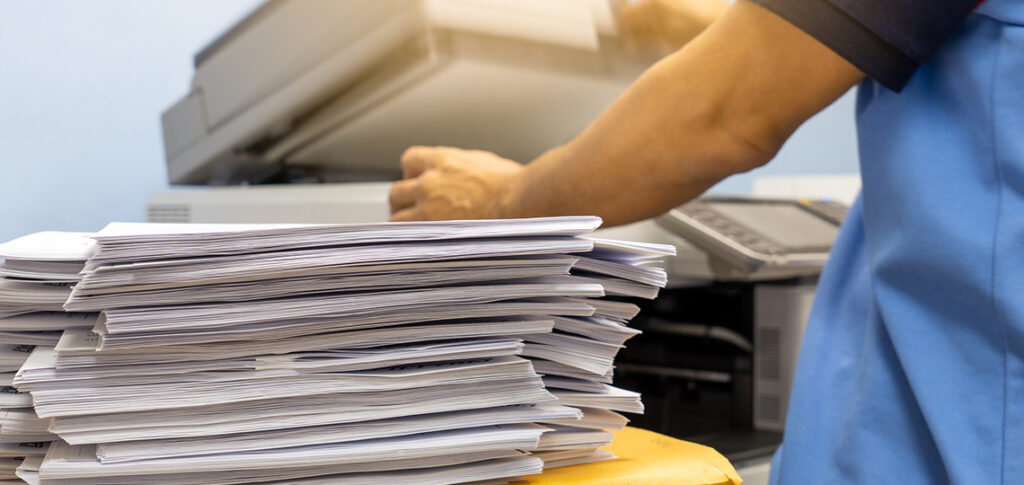The end of this blog has a quick summary of pertinent details for easy reference, as well as a free, downloadable excel spreadsheet for tracking, printing, and sharing per-box inventories!
Getting materials from point A to point B is going to be a big part of your upcoming vendor-outsourced project. The importance of care when shipping materials is sometimes understated, or even overlooked. On the other side of the issue, there can be a lot of anxiety regarding the transit of delicate original materials. What can a library or archive do to help ensure materials arrive at their destination well organized, safe, and ready to be processed?
Picking Your Boxes
For the remainder of this blog, we’re going to imagine the Abril Collection: a special collection of 100 donated monographs, a handful of which are brittle pamphlets. This collection will be arriving at Backstage in Pennsylvania from Maine for digitization and microfilming. How do we start packing these materials?
This may go without saying: but choose a box that fits the size of your books well, that won’t be too heavy once packed, and is in good shape.
- Oversized boxes in ratio to their weight or level of fill are more difficult to handle and can split.
- Overly heavy boxes are much more difficult to handle, and this alone can make fumbles or mishandling during transit more likely.
- Worn-out boxes have lost more structural integrity than you’d expect. This means they may break easily when handled or get distended in transit, allowing books to shift and be damaged.
You don’t necessarily need to purchase a brand-new set of boxes. If you opt to use recycled boxes, make sure the sides, edges, and corners aren’t too soft. If you’re unsure, assume it’s not sturdy enough.


If you choose to use new boxes, you will want to account for this purchase in your project’s budget. What size should you get? That depends on the collection, but for densely packed materials, we recommend smaller boxes. Something in the range of 12” on one side, and up to 16” on the other sides will typically equate to between 15 and 30 pounds.
Packing Your Materials
Dan Polachek, a shipping specialist at Backstage, recommends that every box you pack be lined with bubble wrap or some other form of padding, even if it’s just cardboard. From there, be certain to fill in dead space with packing paper, bubble wrap, or air cushions. If your materials can slide around, they risk getting bumped and bent. Dan will push on the center of a packed box to see if there is give. “If it moves more than an inch or two,” he explains, “you may want to add more packing material.”
Do you have brittle materials? In our hypothetical Abril Collection, we’re going to sandwich the pamphlets in between pieces of stiff cardboard. The edges of the cardboard will take the brunt of pressure and bumping, not the material. Tie this together with string or a rubber band, as long as the band doesn’t force the cardboard to warp. If you think your pamphlets are brittle enough to create unavoidable debris, you can slide the pamphlet-cardboard sandwich into a ziplock or sealable bag. This will keep detritus out of the other materials in the box.

How do you stack materials inside? A little bit of Tetris is okay. Too much Tetris may put materials under pressure. Make sure that your materials aren’t being forced into a space, that overhanging pieces aren’t at risk of being bent, and consider if the way you’ve packed a box will hold up if it gets sat upside down or on its side. Remember that small areas of dead space are best filled with packing material rather than a book wedged into place.



Including An Inventory
Creating a digital inventory of your shipments will have multiple benefits. First: inventories improve communication between the library and your outsourcing partner.
Let’s say that the Abril Collection has 30 titles of its 100 that will be microfilmed for permanent preservation. These titles are interspersed in the collection and, as a result, will be sent to Backstage across multiple shipments. A digital or printed inventory with titles or barcodes and notes will clearly outline the extent of labor in a given shipment, and provide a foundation for asking questions and performing quality assurance throughout the project.
Second: in the event of lost or damaged boxes, it is much easier to confirm missing materials with an inventory. A copy that you and the vendor can use to aid in communicating with shipping providers will make the process easier for all parties.
For each shipment you send, create a regular, repeatable method for noting what is being sent. You could export the relevant brief or acquisition records from your catalog into a bound PFF; more simply, you could send an excel file of barcodes, ISBN, or other identifying number. Barcodes are very simple to scan if you need an inventory quickly without spending overmuch time on this step in the process.
In your inventory, which is most helpful when separated by box, include the name of the project, the shipment number, and the anticipated quantity of materials in the box.
Taping It Up & Labeling
Tape down the top of the box, on the long opening and on the short openings, from corner to corner. If you’re concerned about the weight of the shipment or want to go all-out in protecting your materials, you can also tape up the bottom short openings, from corner to corner, to bolster the strength of the edges. This step isn’t necessary, but it doesn’t hurt, either.
Each box should contain an inventory, so the next step may not be necessary. However, it does aid in communication, and if for some reason you’re unable to include an inventory (not enough time, or not sure what’s in your inventory – this happens occasionally with donated collections!), you may want to consider labeling the outside of your boxes. In the top left corner of the side of the box, or in any space that seems to be regularly available on the outside of each box, label which box it is out of how many are being shipped (1/5, for example) and include some identifier about your institution or project ID, if known. In the example of the Abril Collection, we might say “ABRIL, 1/5”.
Estimating Costs
Shipping and receiving costs can get pricier than you’d expect. UPS has a shipping cost calculator available that provides a good ball-park of what the cost of shipping would be. Make sure you factor in the return trip as well. Don’t forget: prices tend to increase around major holidays.
If you’re budgeting for your project, consider the following:
- Cost of shipping per shipment, to send and to have it sent back
- If you’re buying new ones, the price of cardboard boxes
- Packing materials – do you need to order some bubble wrap?
- Packing tape; this is frequently close to a negligible cost, but worth remembering.
- Labor of staff to pack and send materials.
The Core Takeaways
BOXES:
- Pick sturdy boxes in good shape.
- Keep boxes between 15 and 30 lbs.
- MOST MEDIA: 12″ on one side and up to 16″ on another typically provides a healthy range for box size. For example: 12″ x 12″ x 12″ or 15″ x 10″ x 12″ boxes.
- Oversized materials and reels of microfilm will not fit into these size recommendations, but it’s recommended that the weight not exceed that 15 – 30lb limit. If your filled box feels floppy, you may need to scale back in size.
PACKING:
- Line your box with bubble wrap.
- Fill in dead space with packing paper, bubble wrap, or air cushions.
- “Give Check” – when you press down on the sides and top, is there more than two inches of give? If so, pad it out some more.
- Sandwich brittle materials in cardboard.
- Pack materials firmly, but don’t overpack.
INVENTORY:
- Include a separate box inventory in every box.
- Inventories should include a unique identification, such as barcode, ISBN, or title, and the name of the originating institution.
TAPING:
- Fully tape down top.
- Optionally, tape up bottom corners for added stability.
LABELING:
- Include box x / total boxes (1/5 for box one in a shipment of five).
- Include an identifier about the project, collection, or originating institution. Abbreviations are fine!
ESTIMATING COSTS:
- If shipping UPS, you can use their shipping cost calculator.
- Factor in the cost to ship, AND the cost to have it returned.
- Cost of cardboard.
- Packing materials, such as bubble wrap.
- Packing tape.
- Labor of staff and their time.
We’ve created a simple, free inventory spreadsheet for you to save and use in your future outsourcing projects. Click to start a download!
If you’d like to know more about outsourcing with Backstage or have questions from something in this guide, call us at 1.800.288.1265, visit us online at www.bslw.com, or send an email to info@bslw.com.





